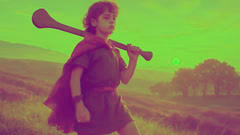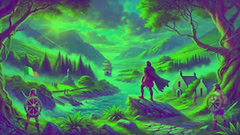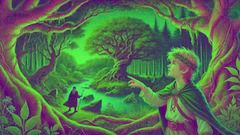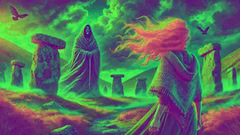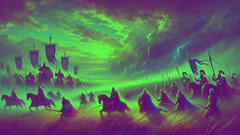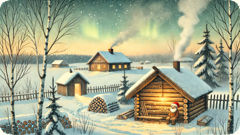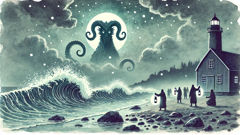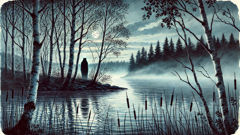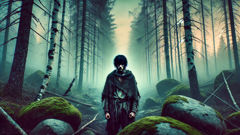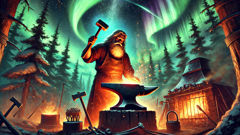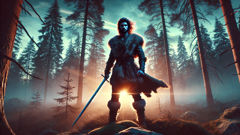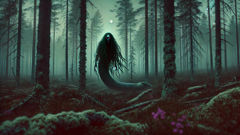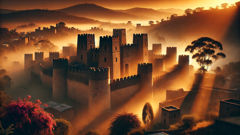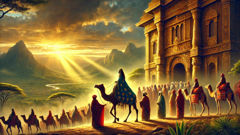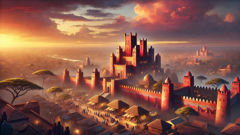Introduction
There is a wind that still sweeps the heathered hills and rugged coastlines of ancient Ulster, whispering stories older than memory. The land remembers a time when heroes walked beneath storm-tossed clouds, their deeds echoing between the green valleys and stony fields. Among all the champions of Ireland’s mythic past, none blaze more brightly in the tapestry of legend than Cu Chulainn, the Hound of Ulster. Even as a child, his destiny shimmered like a blade in sunlight—restless, wild, and unstoppable. Born as Setanta, he was no ordinary boy. His mother, Deichtine, bore him with the blessing of the god Lugh, and from his first breath, signs marked him for greatness. Yet greatness is never easily won. The ancient world was as brutal as it was beautiful, ruled by kings and druids, haunted by spirits, and brimming with dangers both natural and supernatural. For the youth destined to be called Cu Chulainn, every day was a test, every sunrise an invitation to prove himself anew. This is the story of how a spirited, unyielding child dared to challenge fate, how he won his name in blood and valor, and how, in a world woven with wonder and peril, he rose from Setanta the boy to Cu Chulainn the legend. The tales of his boyhood deeds swirl with adventure: games that became battles, contests that turned to prophecy, and one fateful night that would forever mark his place in the annals of Ireland. Let us walk the green paths and shadowed halls of Ulster, and witness the making of a hero whose echoes endure even now.
The Wild Child of Emain Macha
The fortress of Emain Macha was a place of pride and pageantry, where the warriors of Ulster gathered under King Conchobar’s rule. Its halls rang with laughter, with music, and sometimes with the clatter of practice swords as boys trained for the day they would become men. But none among them was as wild or as precocious as Setanta. Even at six years old, he was different. His eyes sparkled with an uncanny light, and his limbs seemed forged from the same iron as the heroes he idolized. He listened, spellbound, to stories of the Red Branch Knights—the bravest of Ulster’s warriors—and when he grew tired of listening, he snuck away to practice their feats in secret.
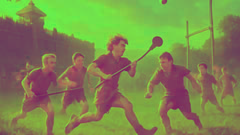
Setanta was the foster-son of King Conchobar himself, raised among princes and noble-born children. Yet he found little joy in pomp or politeness. The fields and woods called to him more than any feast hall. He could hurl a spear farther than boys twice his age, outrun a wild hare through tangled thickets, and leap over brooks without breaking stride. The warriors would watch, bemused, as the small boy mimicked their drills, driving himself beyond exhaustion, unbending and unafraid. His mother worried; his foster-father watched with a mixture of pride and apprehension. For sometimes the boy’s strength flickered with something more—a shadow of the supernatural.
One day, as the warriors rested in Emain Macha, Setanta slipped away from his nursemaid and found himself among the older boys, who were playing the fierce, chaotic game of hurling. None recognized him at first, this small, muddy child who demanded to join their match. The boys laughed, thinking to mock him. But Setanta would not be deterred. He seized a hurley, and when the ball flew into play, he ran with a speed that left the others gasping. Dodging, leaping, whirling—he scored goal after goal. Their laughter turned to awe, then anger, as the older boys realized they were being bested by a mere child. Tempers flared. Sticks were raised, not for the game but for a brawl.
But even surrounded, Setanta fought with a fire none could match. He darted through their ranks, ducking blows, his face fierce with joy. When the commotion reached the ears of Conchobar, the king rushed to intervene—only to find his foster-son standing over a heap of older boys, victorious and beaming. The king realized then that Setanta was touched by destiny, and the Red Branch Knights murmured among themselves, wondering what manner of champion he might become.
The Fateful Feast and the Slaying of Culann’s Hound
The day of Culann’s feast dawned bright and clear. The blacksmith Culann, famed throughout Ulster for his artistry, had invited King Conchobar and his bravest warriors to a grand banquet in his hall. The king prepared to leave Emain Macha in high spirits, his retinue in tow. Setanta, having overheard the preparations, begged his foster-father to let him join. But the king, thinking the boy too young for such company, left him behind, promising a tale of the festivities upon his return.
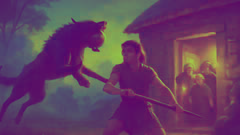
Setanta was undeterred. As the echoes of hoofbeats faded from Emain Macha, he resolved to follow. With only his hurley, his ball, and a crude javelin, he set off across the wild fields, his stride steady and sure. The journey took him through whispering woods and along the banks of glittering streams. At every step, he practiced his skills—hurling the ball before him, chasing it, leaping over brambles as if the land itself could not slow him. By dusk, he reached Culann’s hall, his heart pounding with anticipation.
Within the stone walls, the feast was well underway. Meat sizzled on spits, laughter echoed through the rafters, and the air was thick with the scent of mead. Culann, ever cautious, had set his ferocious hound to guard the entrance once the guests arrived. The beast was famed for its size and savagery, a terror to thieves and wild animals alike. Its growl was enough to chill the marrow of even the bravest men. As Setanta approached, the hound heard his steps and erupted from the shadows, all teeth and fury.
The boy did not run. He stood his ground, gripping his hurley and ball. As the hound lunged, Setanta’s instincts took over—those same instincts that had made him a champion among boys. With perfect aim, he struck the ball so it flew down the beast’s gaping maw, choking it mid-leap. As the hound staggered, Setanta seized his javelin and drove it home. The beast fell, silent and still.
The commotion brought Conchobar and his warriors rushing outside. They found Setanta standing over the slain guardian, breathless but unbowed. Horror flashed on Culann’s face—his beloved hound was dead. But before grief could become anger, Setanta spoke. He offered to become Culann’s new hound, to guard his home until another could be reared. Moved by his courage and honor, the king declared that from that day forward, Setanta would be called Cu Chulainn: the Hound of Culann. The boy had won his true name—and with it, a place in legend.
Training Under Shadows: The Ríastrad and the Warrior’s Path
With his new name, Cu Chulainn’s days became a ceaseless test of skill and endurance. The Red Branch Knights took him under their wing, training him in the arts of war and wisdom alike. His small frame belied a strength that seemed to grow by the day, fueled not just by practice but by a wildness deep within. But it was not just discipline that set him apart—it was something older and more frightening: the warp-spasm, or ríastrad.
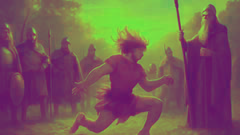
It began in moments of excitement or anger. Cu Chulainn’s body would twist and contort, his muscles knotting with impossible power, his features darkening into something barely human. The druids whispered that such fits were a sign of the gods—a gift and a curse. Many feared him in these moments, for the boy became a tempest unleashed. Yet when the ríastrad faded, he was once again Setanta at heart—eager, thoughtful, and full of laughter.
King Conchobar and the wise Cathbad the druid watched over him closely. Cathbad, seeing greatness within, tested Cu Chulainn with riddles and prophecies. One day, as dawn painted the sky, Cathbad declared: “Whoever takes up arms this day will become the greatest hero Ireland has ever known—but his life will be short and filled with sorrow.” Cu Chulainn heard this and without hesitation demanded his first weapons. The king reluctantly armed him, and Cathbad’s prophecy was sealed.
War games became his schooling. He mastered every weapon—the spear, sword, sling, and chariot. With each passing year, his reputation grew. He stood alone against bands of rivals, defeating them with cunning and ferocity. The Red Branch Knights marveled at his discipline, but even more at his compassion. When battles ended, he helped the wounded, wept for fallen friends, and honored every promise he made.
Yet shadows followed him. The ríastrad would overtake him in moments of danger, and though it protected him, it set him further apart from other children. He became both cherished and feared—a boy touched by destiny, forever marked by the supernatural wildness within.
Conclusion
As Cu Chulainn grew from boy to youth, his legend only deepened. The memory of his boyhood deeds—his triumph on the hurling field, his slaying of Culann’s hound, his battles against rivals and the furious ríastrad—became woven into the very soul of Ulster. People whispered his name with hope or dread, for they knew he would shape the fate of their land. Yet beneath all his strength and ferocity, there remained a sense of longing—a wish for peace, for belonging, for an end to the constant testing of his spirit. The gods had marked him for greatness, but also for tragedy. Even so, Cu Chulainn met every challenge with courage and honor. His story reminds us that heroes are forged not only in battle but in the choices they make and the burdens they bear. The boy who once played hurling among mocking boys became Ireland’s mightiest champion—a symbol of both wild youth and unbreakable resolve. In every valley and on every breeze, the tale of Cu Chulainn endures: a testament to the fire of youth and the price of greatness.

